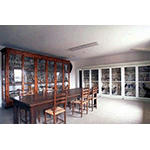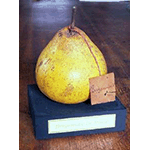Istituto Tecnico Agrario Statale [State Agricultural Technical Institute]
Founded in 1882 under the name of Regia Scuola Agraria di Pomologia e Orticoltura [Royal Agricultural School of Pomology and Horticulture], the institute occupied premises in the Pavoniere building. The school was granted for use by the City of Florence a portion of the present-day experimental farm, which was later enlarged. In 1931 the Scuola Agraria became the Istituto Tecnico Agrario and five years later it moved to its current location. In addition to the collections it owns at present, the Institute is about to acquire a donation of Tuscan minerals, offered by the "Florentine Mineralogists Friends", and a privately donated collection of historic naturalist photographs, books and specimens. The various collections will go to make up a Museum of Agricultural Education.
The naturalist collection (around 4,200 specimens from the 19th and 20th centuries) is divided into several sections: botany (plaster models of flowers and mushrooms, herbariums and samples); zoology (specimens preserved in alcohol and and naturalised specimens of invertebrates, fish, amphibians, reptiles, mammals and stuffed birds); anatomy (plaster models of anatomical parts and a human skeleton); geology and mineralogy (minerals and rocks); palaeontology (fossils coming mainly from Tuscany). Especially important, in the botany section, is the historical collection of models of vegetables, pit-fruit and stone-fruit trees. The plaster and resin models, crafted by Francesco Garnier Valletti, were purchased by the Institute in 1888, while those in wax, dating from the early 20th century, are the work of Vincenzo di Majo.
La technical-scientific agricultural collection (around 456 specimens from the 19th and 20th centuries) includes instruments used in agronomy, physics, chemistry, topography and meteorology, as well as models of constructions. Especially interesting are some models of different types of crops, and a plaster model representing the Italian colonies during the Fascist period.
The botanical collection botanica consists of around 100 historic plants grown in hothouses.
The seed collection contains agricultural seeds from mainly European species, some of them preserved in their original boxes, a collection of live olive seedlings and one of olives preserved in alcohol. The collection, now pending arrangement, may be visited upon request.
The collections are displayed in the original wooden cabinets, occupying six rooms on the first floor of the experimental farm building. One room is used as a storage deposit (the "fruttaio"). The two greenhouses contain the historic plants and others used for study or for sale.
The Library of the Institute (around 12,000 volumes) contains historic archives, a group of volumes from the 16th century and modern works for consultation.
****************************
Texts by Laura Celli
English translation by Catherine Frost
Last update 13/feb/2008





